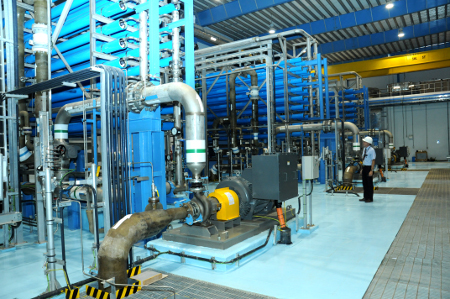Using AI to control energy for indoor agriculture
30 September 2024
Published online 26 November 2014
Ensuring access to clean, fresh water is among the major problems faced by the world’s growing population. As global water resources dwindle, the abundance of available seawater becomes an obvious option to fulfill water requirements through desalination.

© KAUST
Desalination plants have evolved rapidly during the last two decades to extract fresh water from the sea. Currently, approximately 150 countries rely on desalination to meet their fresh water requirements. Globally, around 80 million m3 of potable water is being produced daily by more than 17,000 desalination plants and of these, 50% are utilizing sea water as the source1.
While most countries in the Middle East are rich in fossil energy resources, water is a rare commodity in the region2 3. According to the AQUASTAT report published in 2005, 4.4% of the world’s population inhabit the Middle East, but it only receives 1.1% of the global renewable water resources4.
Developing efficient technologies and scalable infrastructure to meet potable water demands is, therefore, among the chief priorities of local governments. Desalination of the brackish water from the Arabian Sea and the Gulf Sea is an obvious solution to the problem and focus of R&D in the Middle East and 70% of the world’s desalination plants are located in the Middle East. Saudi Arabia alone is producing 20% of the world’s desalinated water.
There are two well-developed desalination technologies: thermal desalination and reverse osmosis (RO) desalination. Both are being used in the Middle East with Saudi Arabia running the world’s largest thermal desalination plant, producing (640,000 m3 per day).
Since the 1960’s, water authorities in the Middle East have been using thermal desalination as the major process to produce potable water. However, the high-energy demands of thermal desalination have shifted the focus to less energy intensive desalination technologies such as RO.
Globally, 70% of the thermal desalination plants have already moved over to RO but, in the Middle East, only 50% of desalinated water is treated in this way because the membranes used for RO process have yet to be fully customized for the high salinity of Red Sea and Gulf seawater5. Another limitation is the high temperature of the region which impacts the operational capacity of RO plants.
Most current research in this technology is focused on the development of new high throughput membranes which can operate at low pressure and high temperature and are resistant to fouling contaminants6. But researchers also need to further focus on the development of pretreatment processes considering the high-salinity of Persian Gulf and Arabian seawater.
There are several new desalination technologies being developed to reduce consumption and produce sustainable desalination processes based on renewable energies.
Adsorption Desalination (AD) is considered as one of the most energy efficient processes available. A team of researchers at King Abdullah University of Science and Technology (KAUST) have conducted a successful pilot and the first industrial scale AD pilot has been approved for construction in Saudi Arabia7. AD can use direct solar energy or industrial waste-heat to desalinate high-salinity water, but there are still issues with its initial capital cost which need to be addressed through modeling and investigating its payback cycle.
Membrane distillation (MD) is a thermally driven low-energy process that utilizes a hydrophobic, microporous membrane to separate fresh water by liquid-vapor equilibrium. The process is based on the combination of conventional distillation and membrane technologies involving heat and mass transfer.
Preliminary studies have shown that with higher flux hydrophobic membranes can produce good quality water at temperature gradients as low as 10°C between the hot and the cold streams8. However, several major hurdles, including the low permeate flux and low thermal efficiency of MD modules, prevent its mass commercialization. More research is needed to develop novel MD membranes with high throughput to increase the permeate flux and thermal efficiency by using industrial waste-heat or by incorporating the direct use of solar energy9 10.
Forward osmosis (FO) processes can be used directly or indirectly to make the desalination process more energy efficient. Indirect FO desalination processes use low salinity feed solution like wastewater to dilute higher salinity seawater and produces partially desalinated water, which can be used for irrigation. Ongoing research shows that the fouling on membrane surfaces is lower while a complete removal of contaminants, such as micropollutants, natural organic matter, trace metals and nutrients from the feed water is possible11 12. However, there are still a number of aspects that need to be explored before the technology can be applied for commercial production in the Middle East. The development of high throughput FO membranes will be a breakthrough towards process scale-up and commercialization.
As the demand for fresh water grows in the Middle East, the future of desalination will depend on combining established and emerging technologies. Researchers need to focus on the hybridisation of forward osmosis (FO), membrane distillation (MD), and adsorption desalination (AD) coupled with and without conventional desalination processes such as thermal desalination and reverse osmosis.
This combination will assist the development of energy efficient and renewable energy-driven desalination technologies. Besides development of energy efficient and environment-friendly desalination technologies, good planning and management of water resources is essential. There is a huge potential in reusable water techniques to improve utilization of treated domestic and industrial wastewater to produce ample fresh water supplies.
Faisal Wali is the operations manager at the Water Desalination and Reuse Center, King Abdullah University of Science and Technology (KAUST) in Saudi Arabia.
doi:10.1038/nmiddleeast.2014.273
Stay connected: